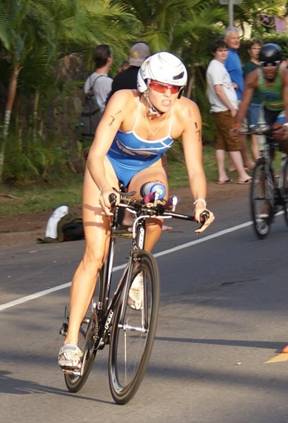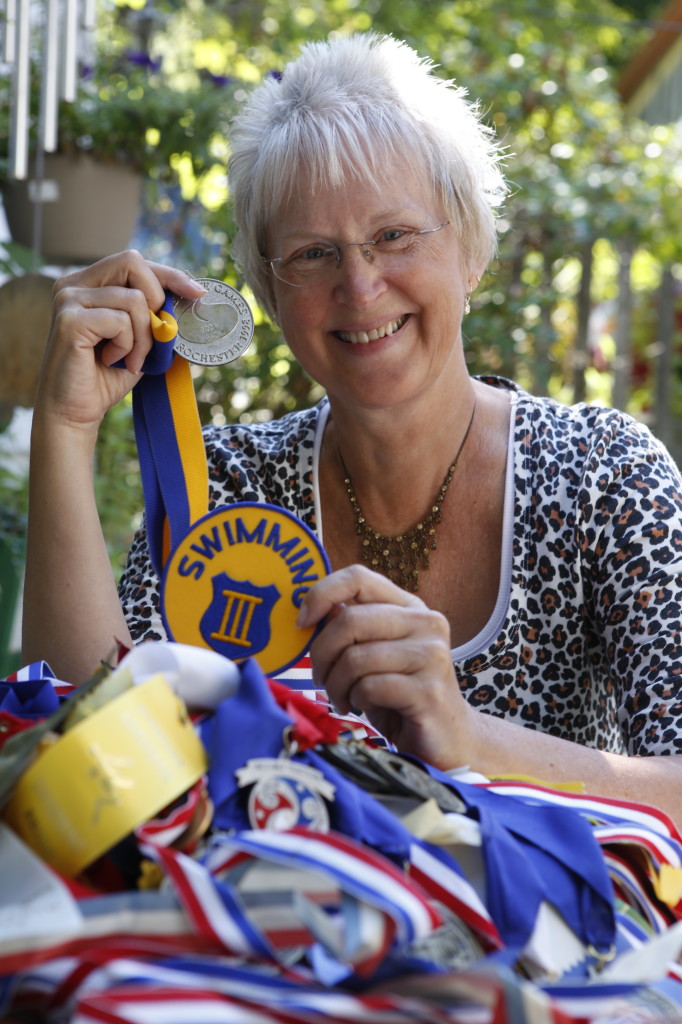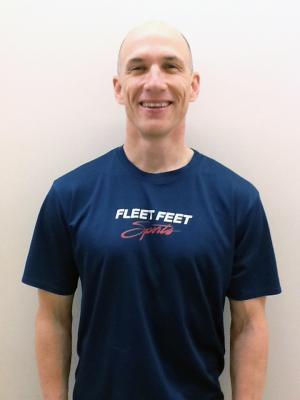One if by land,
Two if by sea…
Three if by bike.
Lectie Altman was a champion swimmer at Nottingham. Writer Ed Griffin-Nolan describes how she’s added biking and running to become one of the world’s up-and-coming triathletes.
If you’re standing on the beach in Hawaii the morning of Saturday, Oct. 11, the first woman you’ll see emerge from the Pacific Ocean after the first leg of the Kona Ironman World Champion race may very well be Syracuse native Lectie Altman.

After that 2.4-mile ocean swim, Altman will race to her bike and battle fierce crosswinds as she cycles 112 miles across bleak lava fields. Then, in front of thousands of spectators, including her mother, she’ll finish her day with a full marathon run of 26.2 miles.
Altman, who turned 30 last month, grew up on Parkway Drive at the edge of Syracuse’s Strathmore neighborhood. Her mother and father still live in the house just down the block from the pool at Onondaga Park where she took early swim lessons and later worked as a lifeguard.
Lectie Altman lives on the Hawaiian island of Oahu, where she trains daily in pursuit of her dream of becoming a professional triathlete. This will be her second time tackling Kona, the race often described as the toughest single day endurance race in the world. In 2012, she completed the course in 11 hours, seven minutes and 23 seconds. She hopes to do better in the fall.
This year, she qualified for Kona in June at the half Ironman competition in Honolulu, where she was the first overall amateur winner, besting even the male amateur athletes.
Triathlons come in many distances, but they all start with a swim followed by a bike ride and then a run. The IronMan is the longest and toughest of all, and Kona’s punishing course, with its waves and stories of tiger sharks (they’ve been spotted during races, but no swimmer has been bitten), is open only to those who can qualify.
Altman will tell you that she’s become a pretty good biker. She’s trained herself to run fast enough to qualify for the Boston Marathon. But her hopes rise and fall with her unnatural ability in the water. Altman was a swimming prodigy who began to practice at age 7 with the Syracuse Chargers team. But her mother, retired postal worker Nona Altman, says she always thought her only daughter and first child would be a swimmer. Nona recalls taking Lectie to the Tiny Tots swim program at the downtown YMCA when she was 6 months old.

“She loved the water,” says Nona, who will be in Kona in October to watch the championship race. “As a tiny baby, when I’d give her a bath, at night, she loved being under water.”
When Lectie was 6, her parents (her dad is retired postal worker Jack Altman) took her to synchronized swimming. That same year, Lectie went to a free clinic put on by the Syracuse Chargers swim club. She hopped out of the water and pronounced it “the most fun I ever had in my life.”
“She stayed with the Chargers all through high school and swam with them on her breaks from college,” says Nona Altman.
Her mother recalls only once in five years that her daughter came in second. “Every other time it was first place.” And Lectie doesn’t recall a single meet during high school and college at which her parents were not there to cheer her on.
The swimming life became a passion for Lectie.

“When she was 14, she decided that she wanted to swim twice a day,” says her mother. “A coach at SU said he would let her in the pool if she could get five kids to do it.”
So young Altman persuaded five of her friends to join her for swim practice at 5 a.m., in addition to their regular prctice 5 to 7 p.m.
Her mother and father took turns with the other parents getting up at 4 a.m. to get the swimmers to the pool. Lectie attended Catholic school at St. James, on Salina Street in the Valley, but transferred to Levy Middle School so she could be on track to attend Nottingham. (Most Catholic high schools didn’t have swim teams).
She raced the 100-meter backstroke and the 200-meter freestyle for Nottingham and competed with the Chargers team, as well.
“My best event with club swimming was the 200-meter backstroke,” she recalled recently in a phone interview from Hawaii. For six consecutive years, she went to the Eastern championships and won first place in her event.
High school success, including trips to state championships, led to college scholarship offers. She knew she wanted to be at a Division I school and on a team where the men and women swimmers trained together. Co-ed practice, she believes, “makes the team more cohesive, and having men in the pool makes me faster by trying to beat some of them.” Even today on her blog posts you can detect a certain delight when she bests a male competitor.
She remembers high school swim team training as “all consuming, but it wasn’t a chore. I loved it.” College-level training turned out to be even more arduous, and just as much fun.
“From the time I was 12, I’ve been swimming six days a week, two hours a day Monday through Friday, two and half hours on Saturday, and doubles in summer.”
Even today she finds training fun. On her 30th birthday, on June 22, her friends surprised her with a party that included 30 laps of 100 meters each.
She eventually chose to attend Bucknell, a smaller Division I school in central Pennsylvania. She went to Patriot League championships every year, winning the 200-meter freestyle as a freshman, the 200-meter backstroke the next three years. Altman set school and league records in three events and was named female athlete of the year at Bucknell in both her freshman and senior years.
Yet, when she moved to Hawaii in 2009 because her then-husband was transferred by the Army, she had never swum in open water. According to her mother, Lectie would drive an hour and a half each way to get to a pool. Her friends urged her to try running or biking, but she had no interest. For a time, she gave up fitness training completely. Her marriage ended, and she found she had gained 35 pounds over her collegiate swimming weight.
“I had no aerobic capacity. I hated running, didn’t want to go to the gym. I was not fit anymore, and that was not how I wanted to be. I was trying to figure out what I needed to do to be happy. Something needed to change,” she says. “When I started to be active again, things started snowballing.”
She fell in with a crowd of athletes who have become like family to her. She reconnected with her college coach, who persuaded her to train for the Honolulu marathon in 2010.

That was the beginning of her road back.
She ran her first half Ironman race in 2011, and the next year she took on the Coeur D’Alene Idaho full Ironman distance. Powered by a great swim, she won her age group and a chance to compete in the world championship at Kona four months later. She placed in the top one-fourth of all women and 27th in her age group.
Triathlons are booming in the U.S. and around the world. Hundreds of thousands of athletes compete in more than 4,000 races of varied distances. The numbers of women triathletes is growing; they may soon represent 40 percent of all members of USA Triathlon, the national membership organization. Locally, the IronMan 70.3 competition at Jamesville Beach attracted more than 1,800 competitors to its fifth annual running.
Altman promises her time at Kona this year will be better. Endurance athletes tend to improve during their 30s, so in some ways, she is entering her prime. Her goal is to qualify to become an elite competitive triathlete. That will take some doing. She has some sponsors who provide her with equipment and accessories, but no financial sponsors. She still fits her monster training schedule around her full-time job as a school counselor working with middle-schoolers with special needs.
“All the stars would have to align,” she says.
Her mother and father and her brother, Eric, would like to have her closer to home, but it doesn’t sound like she’s going to move back to Syracuse any time soon.
“I’d like to do Lake Placid (an Ironman triathlon each year in late July) some day. I really miss my family, and picking apples at Beak n Skiff. But I think I could only take the snow for one day, when it has just fallen and it’s all clean and nice. Five months … I don’t know,” she says.
So even one of the world’s greatest endurance athletes finds the Syracuse winter more than she can endure ….
A little more about triathlons
Triathlons come in many distances, but all involve three things: a swim, a bike ride, and a run, in that order.
Brendan Jackson, of Baldwinsville, is one of our area’s best-known athletes, and he began the tri training program at Fleet Feet sports. In the past five years, more than 600 people have gone through Fleet Feet’s programs.
Most triathletes compete at shorter distances. For example, a sprint triathlon starts with a 750-meter swim, a 20K bike ride and finishes with a 5K (3.2 mile) run. The Olympic distance is twice as long as the sprint. An Ironman competitor swims 2.4 miles, bikes 112 miles and runs 26.2. A half Ironman consists of … well, you can do the math. It totals 70.3 miles, which explains the stickers you see on mini SUVs in front of you at the traffic light by Wegmans.
If that seems like a lot of work, consider the amount of training involved. Before an Ironman triathlete slips into a wetsuit, dons a bathing cap and sets out on the swim, he or she has spent months and months training. To finish the race requires discipline, long hours of training and a dose of good luck.
On Sunday, July 27, in Lake Placid, Jackson found himself out of luck as Mother Nature unleashed a downpour just as the race began.

In spite of his intense training, a thunderstorm, torrential rains and a sudden 20-degree drop in temperature caused him to abandon his quest to complete his second Lake Placid Ironman.
“You could not have created worse conditions if you tried,” said Jackson in a phone interview when he had finally warmed up, a few hours after the race. “At one point, there was three inches of water washing across the road.”
Jackson was among the last swimmers to make it out of the water on Mirror Lake before lightning strikes caused organizers to end the swim portion of the race. Nearly 800 swimmers of the almost 3,000 registered for the race were directed to shore. They could not complete the swim, but were allowed to continue on to the bike portion of the race.
Jackson came out of the water, stripped off his wetsuit, donned his helmet and biking shoes and started cycling. It didn’t take long before he found himself shivering so badly he could not control the bike. He made his way to a van provided by the race and hopped in to try to get warm. The van brought him back to Lake Placid. Waiting there were his wife, Jenny; son, Seth; and many of his Fleet Feet colleagues.
Sometimes, says Jackson, no matter how hard you train, you have to be wise enough to admit that it’s just not your day.
“Guys with more body fat or with a heavier jacket were still going on,” he said. “For me, it just wasn’t safe.”
With that went endless hours of training and his chance to win a spot at the world championships in Kona.
Will he try it again? No comment, says Jackson, though no one who knows him would be surprised to find him out there training soon.






